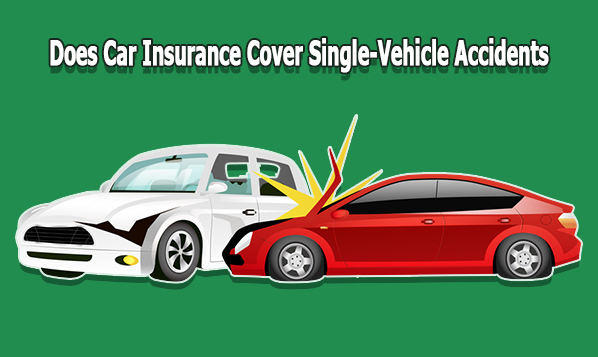Single-vehicle accidents are more frequently reported than car accidents involving multiple vehicles. They are not necessarily less serious than other kinds of auto accidents just because they only involve one vehicle. However, this raises the question of whether car insurance would cover single-vehicle accidents.

An automobile accident involving just one vehicle is called a single-vehicle accident. Your actions after an accident involving one car differ slightly from those you would take after an accident involving two or more vehicles. This article explores the definition of a single-vehicle accident, its insurance coverage, and the legal implications of such incidents.
What Is A Single-Vehicle Accident
As previously stated, an automobile accident involving just one vehicle is called a single-vehicle accident. In just a few seconds, being in an accident can completely alter a person’s life. A person’s savings, life ambitions, and mental health may suffer as a result of the financial costs combined with possible physical and psychological trauma. Additionally, there are several ways that a single-vehicle collision can occur:
- Driving off the road
- Running over items or trash on the road
- Rolling the car
- Colliding with trees or rocks
- Driving too fast for the conditions
- Driving while distracted
In a single-car accident, the car that crashed is the only one hurt, though innocent bystanders or cyclists may also be involved. Moreover, when a settlement cannot be reached, an auto accident attorney may pursue legal action after conducting an investigation and negotiating with insurance companies.
Does Car Insurance Cover Single-Vehicle Accidents
Your car insurance company may cover damages from single-vehicle accidents up to your deductible if you have collision and comprehensive coverage. You will be responsible for paying for any damage out of pocket if you do not have comprehensive or collision insurance. Furthermore, insurance providers may increase premiums for single-car incidents after policy renewal, as many are considered “at fault.
How Does Car Insurance Cover Single-Vehicle Accidents
The type of accident will determine the coverage. Generally, collision coverage is applicable if the damage is thought to have been avoidable. Comprehensive coverage is available for unforeseen and unavoidable damage. For instance, an accident with a telephone pole might be covered by collision insurance as it’s easier to veer away from the pole and its position is fixed. However, since you have no control over the deer’s position or movements, you might be covered by comprehensive insurance if you run into one.
Who is Liable in a Single Vehicle Accident
The conditions surrounding a single-vehicle accident determine who is responsible for the accident. The motorist may be liable if they lose control as a result of speeding, careless driving, or neglect. However, other factors may also be involved, such as weather, mechanical issues, road conditions, or unforeseen impediments.
For instance, it can be deemed an accident rather than the driver’s fault if a driver loses control as a result of an abrupt, unavoidable car failure. Depending on the incident’s particulars, law enforcement, and insurance firms frequently conduct investigations to assign blame.
Common Causes of Single-Vehicle Accidents
A single-vehicle collision can happen for several reasons. The legal liability for an accident does not include the negligence of a second driver, unlike in common auto accident cases. However, external factors such as the environment and road conditions could contribute to this issue.
The following are common reasons for single-vehicle accidents:
- Potholes and other flaws on the road
- Roadside debris or things
- Risky areas for roadside building
- Collisions with stationary objects or trees
- Speeding, particularly while navigating curves
- Dozing off while operating a vehicle
- Distracted driving
- Driving while texting
- Distractions brought on by travelers or animals
- Driving under the influence
- Equipment failures or faulty car parts
- Animals crossing the road due to bad weather
The car driver may still be eligible for financial compensation if they are not entirely responsible for the collision. Moreover, the driver’s legal options will be determined by which third parties can be held liable for the accident and the other causes.
Can I Leave the Scene of Single Vehicle Accidents
Even if there are no injuries or property damage, it is still a crime to leave the scene of a single-car accident without an official record. To improve the chance of getting assistance or establishing a case against third parties, record the crash details and have the vehicle towed to a mechanic for a comprehensive insurance claim. Leaving the site of a collision that results in property damage or injuries turns into a crime, which carries a hit-and-run felony penalty and possible jail time.
How to Avoid Single-Vehicle Accidents
Single-vehicle accidents are the primary cause of road fatalities and injuries, but proactive driving can help reduce these risks. The following are essential points that can help you avoid single-vehicle accidents:
Car safety
To keep your car in top shape, do routine maintenance and inspections. This involves inspecting the brakes, lights, tire pressure, fluid levels, and other vital components. Mechanical breakdowns, decreased performance, and an elevated risk of accidents can result from neglecting maintenance.
Learn safe driving
Predict possible dangers, modify your driving, stay away from distractions like eating, texting, or using a cell phone, keep a safe following distance, pay attention to your surroundings, and utilize defensive driving tactics to respond quickly to changing road conditions to ensure safe driving.
Prevent impairment
Drugs and alcohol affect judgment, coordination, and reaction time, so avoid using them while driving. Your ability to drive safely is impacted by even tiny levels. To ensure safety, choose a sober driver use public transit when drinking, and avoid driving when tired or under the influence of drugs.
Drive by the circumstances
Adjust your driving to the state of the road. Use headlights, slow down, and extend your following distance when it’s raining. To reduce the chance of losing control in snowy or icy conditions, utilize winter tires, slow down, and refrain from making abrupt movements.

